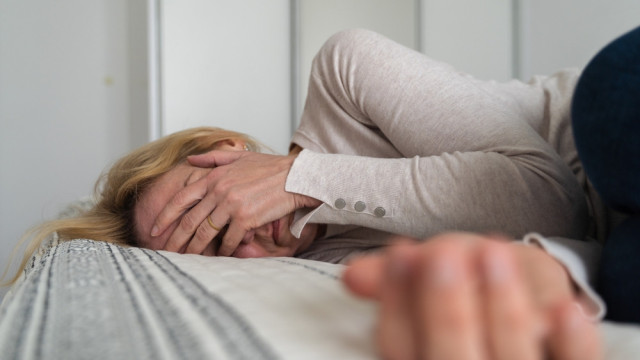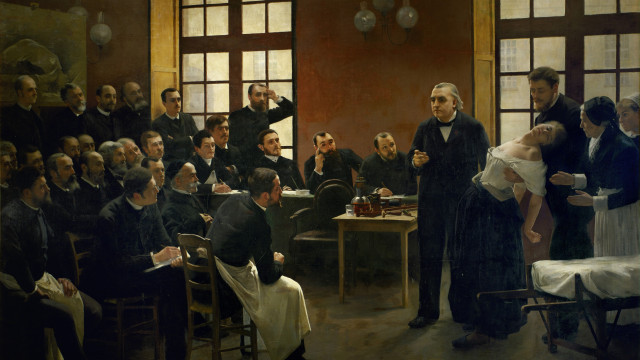




























See Also
See Again
© Shutterstock
0 / 29 Fotos
The arrival of spring
- For many people, the arrival of spring brings a sense of relief. The bitter cold of winter is broken, the days get longer, and the plants and trees come alive.
© Shutterstock
1 / 29 Fotos
Spring and bipolar
- For people living with bipolar disorder, however, the arrival of spring means an increased risk of experiencing a manic episode. While not a clinical diagnostic term, "spring mania" refers to manic episodes in bipolar patients that coincide with changes in light and other seasonal factors.
© Shutterstock
2 / 29 Fotos
Uncertain cause
- Although scientists are not certain what causes spring mania, it is believed to be the result of changing light exposure and circadian rhythm.
© Shutterstock
3 / 29 Fotos
What's important?
- For people living with bipolar disorder, and indeed for those close to them, it is important to recognize the symptoms of spring mania and know how to handle them.
© Shutterstock
4 / 29 Fotos
What is mania?
- Mania is a condition that is typical of bipolar disorder. It is characterized by racing thoughts, pressured speech, and increased energy or activity.
© Shutterstock
5 / 29 Fotos
Symptoms
- Also characteristic of a manic episode are elevated mood, feelings of invincibility, and uncharacteristically risky behavior.
© Shutterstock
6 / 29 Fotos
Further symptoms
- Some of the most common examples of risky behavior include excessive spending, hypersexuality, and a complete disregard for physical health.
© Shutterstock
7 / 29 Fotos
Well-documented phenomenon
- Although it is not possible to be clinically diagnosed with spring mania, the phenomenon is well-documented.
© Shutterstock
8 / 29 Fotos
The cause
- As previously mentioned, experts are not sure what exactly causes spring mania. However, they believe a change in circadian rhythm may play a role.
© Shutterstock
9 / 29 Fotos
What is circadian rhythm?
- Circadian rhythm refers to the way in which our bodies adjust to patterns of light and darkness. It is what prompts us to sleep when it gets dark, and to wake up when it gets light.
© Shutterstock
10 / 29 Fotos
Changing with the seasons
- It is normal for our circadian rhythm to change with the seasons. However, it is thought that the sudden exposure to much more light in springtime may disrupt the circadian rhythm.
© Shutterstock
11 / 29 Fotos
Misalignment
- The hypothesis is that the stark misalignment between our body’s internal schedule and our external environment triggers a misalignment in the brain.
© Shutterstock
12 / 29 Fotos
Exacerbated symptoms
- This misalignment is believed to exacerbate symptoms of mental illness in patients who have conditions such as bipolar disorder.
© Shutterstock
13 / 29 Fotos
Potentially dangerous
- Spring mania can be dangerous, but thankfully the risks and consequences can be managed, both with medication and by making the necessary lifestyle changes.
© Shutterstock
14 / 29 Fotos
Strategies for coping
- There are also some expert-recommended strategies for dealing with spring mania. The first is, as always, to stick to your medication plan.
© Shutterstock
15 / 29 Fotos
Stick to your medication plan
- Bipolar medications help keep symptoms, including mania, under control. You should always speak to your doctor before making any changes to your treatment regimen.
© Shutterstock
16 / 29 Fotos
Try IPSRT
- The next expert-backed tip is to try interpersonal and social rhythm therapy (IPSRT). This is a type of talk therapy that mental health experts use to help bipolar patients understand and manage their biological and social rhythms.
© Shutterstock
17 / 29 Fotos
Stick to a routine
- The next tip? Set a non-negotiable daily routine. This helps bipolar patients keep their mood stable and reduce the risk of both manic and depressive episodes.
© Shutterstock
18 / 29 Fotos
Chart your moods
- Some people who experience spring mania find it helpful to chart their moods. Indeed, for people who experience a slow build in symptoms, the record can act as an early warning system.
© Shutterstock
19 / 29 Fotos
Limit light exposure
- Experts also suggest that people with bipolar disorder should limit their light exposure during spring and summer.
© Shutterstock
20 / 29 Fotos
Limit light exposure
- Indeed, there tends to be an abundance of light during these two seasons, and evidence suggests that an overexposure to it can cause unstable moods.
© Shutterstock
21 / 29 Fotos
Practice good sleep hygiene
- For people who have sensitive circadian rhythms, it is also important to practice good sleep hygiene. This includes making the bedroom a 'no screens' zone.
© Shutterstock
22 / 29 Fotos
Avoid all-nighters
- It is also important to avoid all-nighters. For people with mania, it can be tempting to stay up all night. However, it is important to recognize that the consequences can be dangerous.
© Shutterstock
23 / 29 Fotos
Avoid caffeine and alcohol
- Substances such as caffeine and alcohol are best avoided, since they can make bipolar symptoms worse.
© Shutterstock
24 / 29 Fotos
Avoid caffeine and alcohol
- Indeed, sharp increases in caffeine intake have been associated with manic episodes in people who suffer from bipolar disorder.
© Shutterstock
25 / 29 Fotos
Avoid long-distance travel
- Finally, it is best to avoid long-distance travel during the spring. Studies have shown that moving between different time zones can cause manic episodes in people with sensitive circadian rhythms.
© Shutterstock
26 / 29 Fotos
Spreading awareness
- On a final note, it is important to spread awareness about spring mania, because simply being aware of it can make a huge difference to people whom it affects.
© Shutterstock
27 / 29 Fotos
Spreading awareness
- Furthermore, if the people close to a bipolar patient also know how to recognize the symptoms, they will be better equipped to support the person if they do experience a manic episode. Sources: (Verywell Mind) (Everyday Health) See also: What is rapid-cycling bipolar disorder?
© Shutterstock
28 / 29 Fotos
© Shutterstock
0 / 29 Fotos
The arrival of spring
- For many people, the arrival of spring brings a sense of relief. The bitter cold of winter is broken, the days get longer, and the plants and trees come alive.
© Shutterstock
1 / 29 Fotos
Spring and bipolar
- For people living with bipolar disorder, however, the arrival of spring means an increased risk of experiencing a manic episode. While not a clinical diagnostic term, "spring mania" refers to manic episodes in bipolar patients that coincide with changes in light and other seasonal factors.
© Shutterstock
2 / 29 Fotos
Uncertain cause
- Although scientists are not certain what causes spring mania, it is believed to be the result of changing light exposure and circadian rhythm.
© Shutterstock
3 / 29 Fotos
What's important?
- For people living with bipolar disorder, and indeed for those close to them, it is important to recognize the symptoms of spring mania and know how to handle them.
© Shutterstock
4 / 29 Fotos
What is mania?
- Mania is a condition that is typical of bipolar disorder. It is characterized by racing thoughts, pressured speech, and increased energy or activity.
© Shutterstock
5 / 29 Fotos
Symptoms
- Also characteristic of a manic episode are elevated mood, feelings of invincibility, and uncharacteristically risky behavior.
© Shutterstock
6 / 29 Fotos
Further symptoms
- Some of the most common examples of risky behavior include excessive spending, hypersexuality, and a complete disregard for physical health.
© Shutterstock
7 / 29 Fotos
Well-documented phenomenon
- Although it is not possible to be clinically diagnosed with spring mania, the phenomenon is well-documented.
© Shutterstock
8 / 29 Fotos
The cause
- As previously mentioned, experts are not sure what exactly causes spring mania. However, they believe a change in circadian rhythm may play a role.
© Shutterstock
9 / 29 Fotos
What is circadian rhythm?
- Circadian rhythm refers to the way in which our bodies adjust to patterns of light and darkness. It is what prompts us to sleep when it gets dark, and to wake up when it gets light.
© Shutterstock
10 / 29 Fotos
Changing with the seasons
- It is normal for our circadian rhythm to change with the seasons. However, it is thought that the sudden exposure to much more light in springtime may disrupt the circadian rhythm.
© Shutterstock
11 / 29 Fotos
Misalignment
- The hypothesis is that the stark misalignment between our body’s internal schedule and our external environment triggers a misalignment in the brain.
© Shutterstock
12 / 29 Fotos
Exacerbated symptoms
- This misalignment is believed to exacerbate symptoms of mental illness in patients who have conditions such as bipolar disorder.
© Shutterstock
13 / 29 Fotos
Potentially dangerous
- Spring mania can be dangerous, but thankfully the risks and consequences can be managed, both with medication and by making the necessary lifestyle changes.
© Shutterstock
14 / 29 Fotos
Strategies for coping
- There are also some expert-recommended strategies for dealing with spring mania. The first is, as always, to stick to your medication plan.
© Shutterstock
15 / 29 Fotos
Stick to your medication plan
- Bipolar medications help keep symptoms, including mania, under control. You should always speak to your doctor before making any changes to your treatment regimen.
© Shutterstock
16 / 29 Fotos
Try IPSRT
- The next expert-backed tip is to try interpersonal and social rhythm therapy (IPSRT). This is a type of talk therapy that mental health experts use to help bipolar patients understand and manage their biological and social rhythms.
© Shutterstock
17 / 29 Fotos
Stick to a routine
- The next tip? Set a non-negotiable daily routine. This helps bipolar patients keep their mood stable and reduce the risk of both manic and depressive episodes.
© Shutterstock
18 / 29 Fotos
Chart your moods
- Some people who experience spring mania find it helpful to chart their moods. Indeed, for people who experience a slow build in symptoms, the record can act as an early warning system.
© Shutterstock
19 / 29 Fotos
Limit light exposure
- Experts also suggest that people with bipolar disorder should limit their light exposure during spring and summer.
© Shutterstock
20 / 29 Fotos
Limit light exposure
- Indeed, there tends to be an abundance of light during these two seasons, and evidence suggests that an overexposure to it can cause unstable moods.
© Shutterstock
21 / 29 Fotos
Practice good sleep hygiene
- For people who have sensitive circadian rhythms, it is also important to practice good sleep hygiene. This includes making the bedroom a 'no screens' zone.
© Shutterstock
22 / 29 Fotos
Avoid all-nighters
- It is also important to avoid all-nighters. For people with mania, it can be tempting to stay up all night. However, it is important to recognize that the consequences can be dangerous.
© Shutterstock
23 / 29 Fotos
Avoid caffeine and alcohol
- Substances such as caffeine and alcohol are best avoided, since they can make bipolar symptoms worse.
© Shutterstock
24 / 29 Fotos
Avoid caffeine and alcohol
- Indeed, sharp increases in caffeine intake have been associated with manic episodes in people who suffer from bipolar disorder.
© Shutterstock
25 / 29 Fotos
Avoid long-distance travel
- Finally, it is best to avoid long-distance travel during the spring. Studies have shown that moving between different time zones can cause manic episodes in people with sensitive circadian rhythms.
© Shutterstock
26 / 29 Fotos
Spreading awareness
- On a final note, it is important to spread awareness about spring mania, because simply being aware of it can make a huge difference to people whom it affects.
© Shutterstock
27 / 29 Fotos
Spreading awareness
- Furthermore, if the people close to a bipolar patient also know how to recognize the symptoms, they will be better equipped to support the person if they do experience a manic episode. Sources: (Verywell Mind) (Everyday Health) See also: What is rapid-cycling bipolar disorder?
© Shutterstock
28 / 29 Fotos
What is 'spring mania,' and what can you do about it?
Learn to recognize the symptoms
© Shutterstock
For some people living with bipolar disorder, the arrival of spring can be a turbulent time. With evidence that shows the risk of manic episodes increases as the days get longer, indeed, during springtime the symptoms of bipolar disorder can become more difficult to handle.
Although doctors are not exactly sure what causes so-called "spring mania," it is a recognized phenomenon that people should be aware of. Curious? Read through this gallery to find out more.
RECOMMENDED FOR YOU






























MOST READ
- Last Hour
- Last Day
- Last Week








